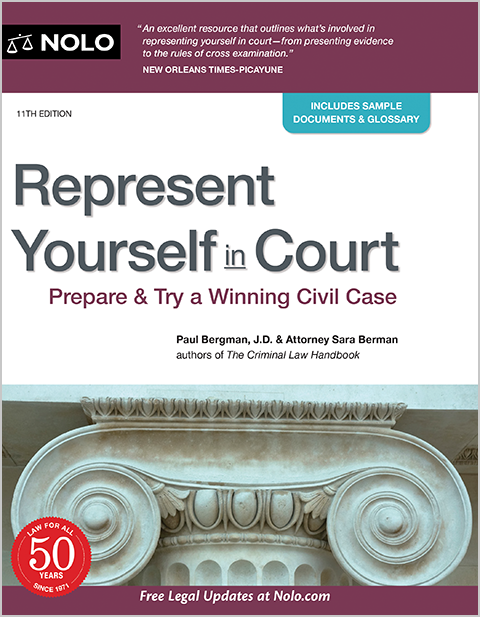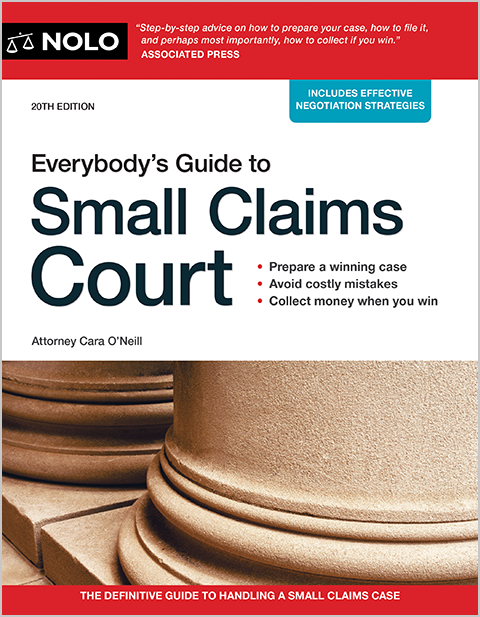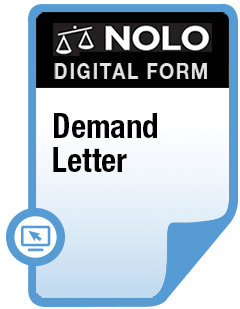You went to court and got a judgment. Now you want to turn that judgment into cash. The first step is usually to get a judgment lien. We'll explain how you do that.
You won a money judgment in a California court case. It says you're entitled to a sum of money from the party you sued, now called the judgment debtor. How do you—the judgment creditor—collect your judgment? That's the focus of this article.
In particular, we explain California judgment liens—what they are and how they work. We'll cover:
- how judgment liens differ from judgments
- California's judgment lien statutes
- how to put judgment liens on California real and personal property, and how long the liens last
- renewing California judgments, and
- how you can collect on a judgment lien.
Need some basic background information before you start? Learn more about court judgments and how they're collected.
How Is a Judgment Lien Different From a Judgment?
A money judgment is a court order that says a judgment debtor owes a sum of money to a judgment creditor. But in most states—including California—a judgment creditor can't simply take their judgment to the county clerk's office and demand a sale of the judgment debtor's property.
Before that can happen, the judgment first has to be associated with, or attached to, specific property. A judgment lien does that, by giving the judgment creditor a security interest in the judgment debtor's property. Once a judgment lien is created, the judgment creditor can demand that the property securing it be sold and the proceeds distributed to creditors, a process called "execution."
Where Can You Find California's Judgment Lien Statutes?
Judgment liens are one method of enforcing judgments, so you'll find the relevant statutes in California's Code of Civil Procedure at Part 2, Title 9 (2025), entitled "Enforcement of Judgments." More specifically, these statutes explain how to attach judgment liens and how long they remain valid:
- Cal. Civ. Proc. Code §§ 697.310-697.410 (2025) (judgment liens on real estate)
- Cal. Civ. Proc. Code §§ 697.510-697.670 (2025) (judgment liens on personal property)
- Cal. Civ. Proc. Code §§ 697.010-697.060 (2025) (general rules regarding judgment liens)
- Cal. Civ. Proc. Code §§ 683.010-683.050 (2025) (period for enforcement of judgments), and
- Cal. Civ. Proc. Code §§ 683.110-683.220 (2025) (renewal of judgments).
Depending on the circumstances, you might need to refer to other statutes found in Title 9.
Putting Judgment Liens on California Real Estate
In most cases, you put a judgment lien on a debtor's California real estate by recording an abstract of judgment—a brief summary of the judgment—with the recorder's office in the county where the real estate is located. A separate abstract must be prepared and recorded for each county where you want to place a judgment lien.
(See Cal. Civ. Proc. Code § 697.310(a) (2025).)
How to Get and Record an Abstract of Judgment
To get an abstract of judgment, complete Form EJ-001 and submit it to the court clerk for the court that issued the judgment. The clerk will prepare a certified abstract. There's a small fee for each abstract.
Then, simply take or mail the certified abstract to the recorder's office in each county where you want a judgment lien. The clerk will record the abstract for a nominal recording fee. Once the abstract has been recorded, a judgment lien attaches to all real estate the judgment debtor owns or later acquires in the county.
How Long Does a Real Estate Judgment Lien Last?
A California real estate judgment lien is good for 10 years from the date the abstract was recorded. It ends sooner if the judgment debtor pays off the underlying judgment or it lapses. If the judgment is renewed (see "Renewing a California Judgment," below), the lien can be extended for another 10 years.
(Cal. Civ. Proc. Code § 697.310(b) (2025).)
Putting Judgment Liens on California Personal Property
California judgment liens can attach only to specific kinds of personal property located in the state, including (but not limited to):
- rights to payments for sales of goods or services, called accounts receivable
- equipment
- farm products, and
- inventory.
Some kinds of personal property are excluded, meaning that a judgment lien won't attach or, if it's already attached, the lien will be extinguished. Among the types of excluded property are:
- motor vehicles and vessels that must be registered
- low cost retail inventory, and
- personal property that's later attached to real estate and becomes a fixture.
(Cal. Civ. Proc. Code § 697.530(a), (d) (2025).)
How to Create a Personal Property Judgment Lien
Creating a personal property judgment lien is straightforward. Simply file a notice of judgment lien, Form JL-1, with the California Secretary of State. Cal. Civ. Proc. Code § 697.550 (2025) details the information you must include. You can file online for a minimal fee.
When you file the notice, or "promptly" after, you're supposed to serve a copy of it on each judgment debtor via process server or by mail. Note that failure to provide the required notice doesn't invalidate your judgment lien.
How Long Does a Personal Property Judgment Lien Last?
A personal property judgment lien is good for five years from the date you file the notice, unless the judgment debtor pays it off sooner or the underlying judgment lapses. You can extend the lien by filing a "continuation statement" within six months before this five-year period expires.
When you timely file a continuation statement, the judgment lien extends for another five years, beginning on the date the original lien would have ended but for the filing of the continuation statement. Successive continuation statements can be filed, each extending the judgment lien for another five years.
(Cal. Civ. Proc. Code § 697.510 (2025).)
Renewing a California Judgment
As a general rule, a California judgment lasts for 10 years from the date it was entered. For judgments payable in installments, this 10-year period runs from the date each installment becomes due. Unless it's been renewed, a judgment becomes unenforceable once this period expires, and all judgment liens based on it are extinguished. (Cal. Civ. Proc. Code §§ 683.020, 683.030 (2025).)
How to Renew
With limited exceptions, you can renew a judgment for successive 10-year terms. You (or your lawyer) must file an application to renew the judgment with the court that issued it. Use Form EJ-190 to make sure your application includes all required information.
You must file a renewal application before the judgment expires. Special rules apply when renewing installment-payment judgments.
(See Cal. Civ. Proc. Code §§ 683.110-683.140 (2025).)
You must notify the judgment debtor, in writing, that the judgment has been renewed. The notice "shall be in a form prescribed" by the California judiciary, and must tell the judgment debtor they have 60 days to oppose the renewal.
Form EJ-195 is the prescribed notice of renewal form.
(Learn more about how to renew a California judgment.)
Extending Real Estate Judgment Liens
Renewing a judgment doesn't automatically extend any real estate judgment liens based on that judgment. To extend a California real estate judgment lien, you must—before the judgment lien expires—file a copy of the judgment renewal application with the recorder's office in the county where the property is located.
If the real estate was transferred subject to your lien before you applied to renew the judgment, the judgment lien won't be extended unless you:
- have a copy of the renewal application personally served on the real estate transferee, and
- file proof of service of the application with the court clerk not later than 90 days after you filed the renewal application.
(Cal. Civ. Proc. Code § 683.180 (2025).)
How to Collect on a California Judgment Lien
There are three ways to collect on a California judgment lien:
- negotiate a settlement
- wait for the judgment debtor to sell or refinance their real estate, and
- execute on your judgment lien.
Negotiating a Settlement
Chances are you won't get the full amount of your judgment, but that's how settlements work. Of the three collection methods, negotiation is likely to be your quickest route to payment. If you're not comfortable negotiating on your own, consider hiring counsel to represent you.
Wait for a Sale or Refinance
You probably won't get paid anytime soon, which can be frustrating. But if you're willing to wait for the judgment debtor to sell or refinance their real property, then you stand a decent chance of getting paid. Why? Because a buyer or lender almost certainly will insist on clear title, meaning no judgment liens.
Odds are the judgment debtor will approach you to make a deal. But here—unlike a typical negotiated settlement—you've got the upper hand. If they want your lien to disappear, they've got to pay you what you're owed. If a buyer is willing to take the real estate subject to your lien, then the waiting game simply continues.
Executing on Your Judgment Lien
Your last—and probably least attractive—option is to execute on your judgment lien. To do this, you'll have to get a special order called a "writ of execution." Then you deliver the writ to the county sheriff with instructions to sell the property.
What follows is a lengthy and sometimes convoluted process that eventually will result in a sale of the property at auction, unless the judgment debtor pays you off or files for bankruptcy first.
If you're considering an execution, speak to a California creditor's rights lawyer. You might find out that forcing a sale isn't worth your while.
Next Steps
We've touched on the basics of California judgment liens, but you probably have more questions. If so, it makes sense to get advice from an attorney who specializes in creditor's rights or collection law. They can provide the answers you need and help you plan a strategy to give you the best chance of collecting what you're owed.



